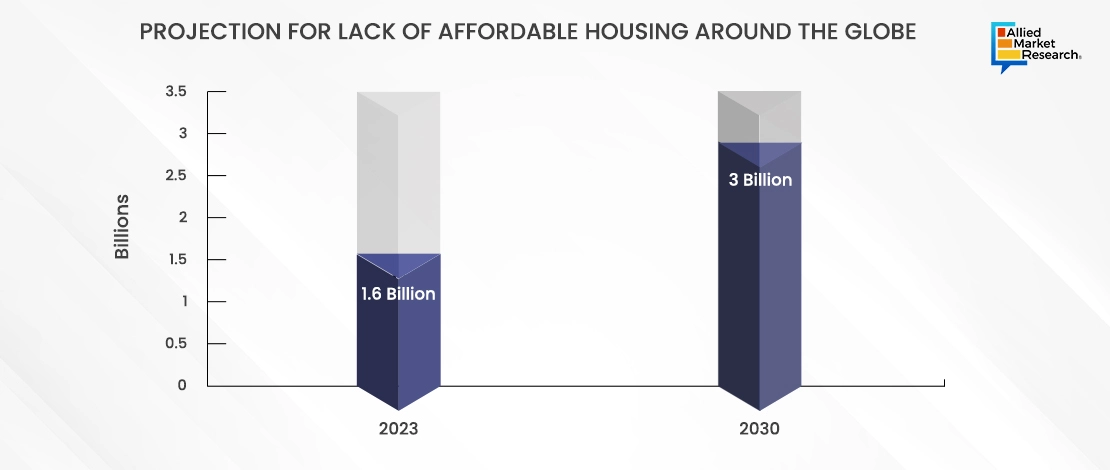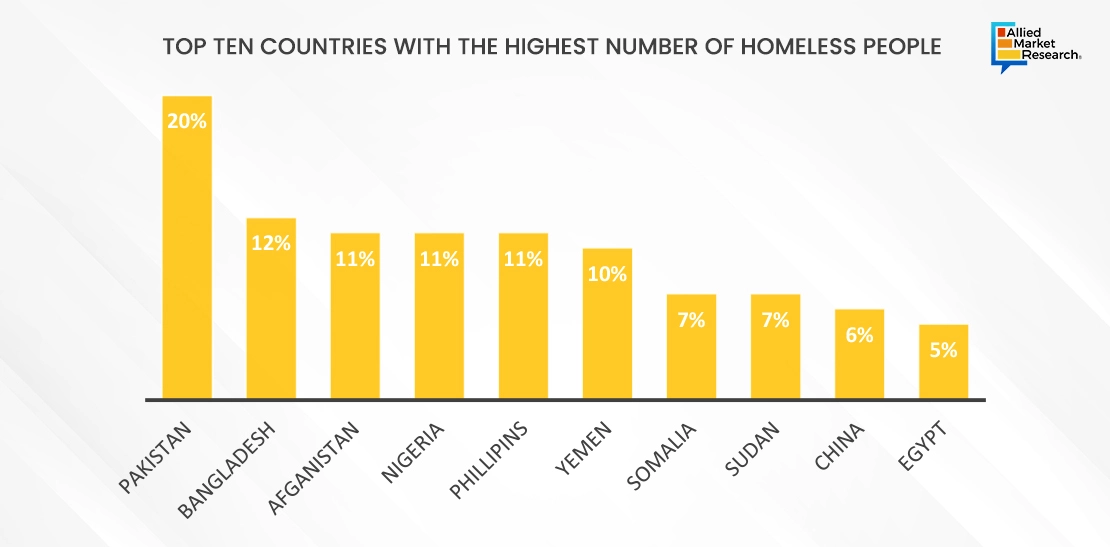Table Of Contents

Yerukola Eswara Prasad

Pooja Parvatkar
Navigating the Surge in Affordable Housing with Innovation and Inclusivity

In recent years, the affordable housing market has undergone a substantial transformation, becoming a pivotal point for policymakers, real estate developers, and communities alike. As the demand for affordable housing continues to grow, it is crucial to explore innovative and inclusive approaches that can unlock the door to dreams for millions of individuals and families around the world. It is crucial to explore the dynamics of the affordable housing market, the challenges it faces, and how innovation and inclusivity can play a pivotal role in shaping a brighter future.
The affordable housing market is estimated to reach $84.7 billion by 2031, growing at a CAGR of 4.9% from 2022 to 2031. According to Balakrishnan Rajagopal, the UN Special Rapporteur on the right to adequate housing, inadequate number of affordable housings is a global phenomenon. In his report to the UN general assembly, he stated that in 2023 nearly 1.6 billion people around the world lack adequate housing and basic services, with projections that this could rise to 3 billion by 2030.

Innovation and Trends in Affordable Housing
Embracing cutting-edge technologies and creative design solutions can lead to the development of cost-effective housing options that do not compromise on quality. Modular construction, 3D printing, and sustainable building materials are just a few examples of how innovation can redefine the landscape of affordable housing.
Modular construction holds immense promise for the affordable housing sector. By assembling prefabricated modules off-site, construction time is significantly reduced, resulting in lower overall costs. This not only addresses the urgency of housing needs but also minimizes the disruption caused by traditional construction processes. The speed and efficiency of modular construction contributes to a more sustainable and scalable approach to affordable housing development.
Furthermore, technology can be leveraged to enhance energy efficiency in affordable housing projects. Integrating smart home solutions and renewable energy sources not only reduces utility costs for residents but also aligns with global sustainability goals. These innovations not only make housing more affordable in the short term but also contribute to long-term environmental and economic sustainability.
Inclusivity in Affordable Housing
Achieving true inclusivity in the affordable housing market goes beyond providing cost-effective shelter. It involves creating communities that are diverse and vibrant and offer opportunities for residents to thrive. This has clearly been stated by the United Nations in its comprehensive report on measuring social inclusion globally. It has established various international agreements guiding social development, such as the Copenhagen Declaration and the 2030 Agenda for Sustainable Development. Inclusivity is about addressing the unique needs of different demographic groups and ensuring that affordable housing solutions are tailored to their requirements. The UN emphasizes inclusive education as vital for all, including persons with disabilities, to combat discrimination.
One crucial aspect of inclusivity is recognizing the diverse needs of urban and rural populations. While urban areas often grapple with issues of density and limited space, rural communities face different challenges, such as access to basic amenities and infrastructure. Customizing affordable housing solutions to suit the specific needs of each context is essential for creating a truly inclusive housing market. For instance, health and education facilities, parks and green spaces, and many others such as facilities are pivotal for social inclusion.
Moreover, an inclusive approach involves collaboration between public and private sectors, NGOs, and community organizations. The Indian Government under the Pradhan Mantri Awas Yojana (PMAY), has drafted policies to incorporate Public-Private Partnerships for the development of affordable housing. The government has also undertaken capacity-building exercises to equip stakeholders with knowledge about affordable housing and PPPs. Engaging with local communities to understand their needs and involving them in the decision-making process ensures that affordable housing projects are not only effective but also culturally sensitive and community driven.
Policy and Regulatory Support
For innovation and inclusivity to flourish in the affordable housing market, policymakers play a pivotal role. Governments need to create an enabling environment through supportive policies and regulations that incentivize developers and investors to invest in affordable housing projects.

Incentives may include tax breaks, streamlined approval processes, and grants for innovative and sustainable housing solutions. For example, in January 2024, the U.S. Department of Housing and Urban Development (HUD) announced that it will make available $150 million in funding for affordable housing projects that benefit low-income families in American Indian and Alaska Native communities. Strong investments in tribal communities help ensure residents can access much-needed safe and affordable housing. The funds HUD is making available will meet the challenges of today and allow Tribal communities to make innovative and vital advancements needed to prepare for the future. HUD will award the $150 million through the Indian Housing Block Grant (IHBG) Competition supporting Tribes and Tribally Designated Housing Entities (TDHEs) to carry out affordable housing activities. The Department will give funding priority for new housing construction projects, housing rehabilitation projects, acquisition of existing housing units that increase the affordable housing stock, and necessary affordable housing-related infrastructure projects. Moreover, policies should focus on promoting mixed-income developments, ensuring that affordable housing is integrated seamlessly into larger communities, and preventing the creation of isolated pockets of poverty.
Furthermore, addressing land use and zoning regulations is essential. Outdated or restrictive regulations can hinder the development of affordable housing projects. For example, in 2014, the Indian Government scrapped the Jawaharlal Nehru National Urban Renewal Mission (JNNURM) scheme, which was launched on December 3rd, 2005, aiming to modernize urban housing and provide affordable tenure for the poor living in urban areas. Despite having many advantages, the scheme was criticized for lack of community participation, failure to extend facilities to the poor, taking a fragmented project-based approach rather than an integrated one, ignoring slum upgrading in favor of new construction, and most importantly the poor implementation of the scheme. Governments must work towards creating a regulatory framework that encourages the efficient use of land for housing purposes while safeguarding the interests of both developers and residents. Affordable housing, investments in the real estate sector, and home loan tax rebates are some of the key expectations of the housing sector for the upcoming Interim Budget 2024 in India. Co-founder and Chief Business Officer of NoBroker.com, Saurabh Garg, said that the upcoming budget should focus on increasing the cap on affordable housing from Rs 45 lakh to Rs 65 lakh, which would enable more people to reap the benefits of the incentives for affordable housing. Meanwhile, Payal Thaker, Partner, Indirect Tax, BDO India said, “Affordable residential apartment meaning should be defined based on the carpet area of the apartment and not on the gross amount charged, since in metro cities, the value of apartments can be significantly higher due to high land costs.”
Global Perspectives on Affordable Housing
The surge in demand for affordable housing is not limited to a specific region or country. Around the world, communities are grappling with the challenge of providing adequate and affordable housing for their citizens. For example, in 2019, nearly 30 million households either had substandard housing or lacked housing altogether. There is a lack of 5.9 million households in Brazil, and this is expected to increase by 1.2 million per year until 2030 due to population growth. Thus, sharing successful strategies and learning from each other's experiences can foster a global dialogue on affordable housing solutions. In July 2023, The Inter-American Development Bank (IDB) approved a $54.5 million loan to Brazil to launch new housing strategies and improve dwelling quality, primarily for low-income people.
International collaboration and knowledge exchange can lead to the adoption of best practices and innovative approaches. Platforms for sharing experiences, such as global conferences and forums, can facilitate cross-border cooperation and accelerate progress towards achieving housing affordability on a global scale. One such initiative is the bi-annual global affordable housing conference which aims to provide a unique platform to share information, learn about the latest innovation and network with peers. In 2023, the 9th Global Affordable Housing Conference was conducted at the World Bank Group Headquarters in Washington D.C., from May 31- June 2, 2023, with a theme of “Looking ahead: unlocking access to affordable, green and resilient housing through innovation”.

Challenges and Roadblocks
One of the primary challenges faced by the affordable housing market is the expanding gap between demand and supply. Rapid urbanization and population growth have intensified the issue, making it necessary for stakeholders to adopt strategic and forward-thinking solutions. It is not merely about constructing more buildings; it is about fostering an environment where everyone has the opportunity to achieve the dream of homeownership. To overcome this challenge, governments across the globe need to update and revise their land acquisition policies, and modify their statutory requirements pertaining to floor space, height of buildings, and others. Along with this, builders need to incorporate new and innovative construction methods to reduce the cost of overall projects as well as complete the project quickly.
The Future of Affordable Housing
The surge in the affordable housing market presents both challenges and opportunities. According to the World Green Building Council, around 80% of the cities in the world do not have an option for affordable housing. The organization states that the government across the world needs to build two billion homes over the next 75 years. For instance, in 2022, the India government completed the construction of 402,000 homes from the level of 279,000 homes that were completed in 2021, marking a significant rise of 44%.
Unlocking the door to dreams for millions of individuals requires a multifaceted approach that incorporates innovation, inclusivity, and supportive policies. By embracing cutting-edge technologies, customizing solutions for diverse needs, and fostering collaboration between stakeholders, to create a future where affordable housing is not just a necessity but a thriving and inclusive reality for all. As we navigate this transformative journey, it is crucial to keep the doors of innovation and inclusivity wide open, ensuring that the dream of affordable and quality housing becomes a reality for everyone, regardless of their economic circumstances. As the population is growing the need for housing especially affordable housing is rising, and the key players in the market must be ready to capitalize on this trend. This is where AMR can help. Get in touch with our analysts.

